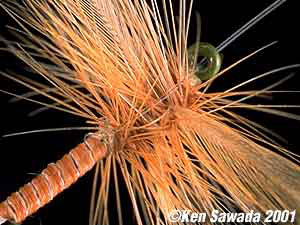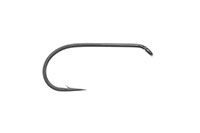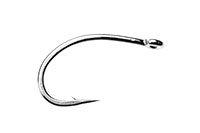
Mountain Streams --Vol.8--
The Posture of the Fly Can Drive the Fish Mad

What part of the fly attracts the fish most?
In my early days of fly fishing it was most difficult to float the dry fly. In those days there was no water repellent material, what is now called dry fly dressing or floatant, to get sufficient buoyancy. Therefore, it took much pain to put the fly on the water surface. That was one of the reasons why some anglers said that dry fly fishing was impossible in Japanese mountain streams. To float the fly, I wound the hackles as thickly as possible. However, now that there was no proper hackle anywhere, I plucked my material from the feather duster. Such situation in those days was reflected by the fact that the fly called Bivisible was popular.

The Noro River up the Hirogawara bank in August 1977.
Poor buoyant fly gets good results in the beginning but soon becomes unreliable. After I land only one fish, I can hardly float that fly again, except for on the flat surface, however hard I make false cast. I remember that the biggest difference between fishing in those days and today is how many times I make false cast. I used to make false cast several times in order to splash the water from the fly that I had picked up. Then I made "real" false cast.
Watching the fly that I managed to float on the water surface, I noticed the fish response much varied according to the condition of the fly floating. In some cases, fish came up well to a brand-new fly but once it caught a fish, fish did not come up to it, even if it floated well. But in other cases, fish did not respond well to the fly as long as it was floating well, while it caught fish well after it could barely float. There were both types of flies. I also remember that fish came up a little better to the well floating flies although I have to add that "well floating" in those days is quite an average level floating today.

The upper reaches of the Kotaki River in August 1976. A commemorative photo we took there, surrounded by a swarm of horseflies.
The Fly Floating High on the Water Surface
The fly floating and drifting high on the surface is clearly visible. It can be seen well from afar. It can be easily seen on the choppy water. Furthermore, it can be drifted beautifully on the intricate flow without sinking since floating high means good buoyancy. Those kinds of performance were indispensable for the dry fly. In other words, there is no dry fly fishing without floating fly. In addition, if the floating fly is not seen well---even if it is floated---, we will have much difficulty. Those kinds of performance should be at the top of list in many cases because the mountain stream often has got ripples. In the first half of 1970's I was indulged in that idea. In those days fishing in the mountain stream meant nothing but dry fly fishing. It was most important to get the fly that was able to float on any stream as long as we aimed at minimizing no-catch spots where some fish stayed.I kept that idea even after I got the floatant that enabled us to get the dramatically increased buoyancy. I still continued to tie the well buoyant-that means floating high on the water surface---flies. Consequently I became free from poor buoyancy. After I could float the fly on the surface as if floating a dandelion seed, as I had long longed for, I was interested in the different responses of fish just as in my early days of fly fishing. I noticed I set the hook to no fish more times by using the high-floating fly. In that case I felt the fish came up at a higher speed and was nervous. What is the disadvantage of the well buoyant fly? What will happen if I use a poor buoyant fly? I felt that fish came up quietly but somehow less frequently to the fly that was barely floating after it caught several fish. What made the fish do so? I did not have the faintest idea.
The Headstand of the Fly
In those days fly hooks we got in Japan were made in Norway or Britain. I exclusively used Britain's because I loved its shape and it was stronger than Norway's. In order to balance its strong but heavy hook, I used as large amount of hackle as possible. Referring to the fishing literature of Britain, the birthplace of fly fishing and dry fly, I saw lots of photos of dry flies tied on the up-eye hook. I felt easily convinced that the hook eye turned upwards, imitating a real mayfly. Anyway, I was more concerned about whether the fly turned upwards or downwards than such explanation. To be honest, I chose the up-eye hook, depending on my feeling. Another reason to choose it, if there had been, was that thread did not slip off the hook even when I wound the hackle on such wide part that there was no space for head left.
When I tied terrestrial with flat wings I always used the down-eye hook.
I went to the Chikuma River in high spirit. I took my dry fly tied on the up-eye hook with me. When I put the leader tip to the upward eye for the first time, the fly seemed to be warped. The hook point turned outward. It may be very difficult to hook up the jaws of trout. Expecting things would go well since it had long been used, I cast it. But when I floated it on the stream, it completely turned upside down. I had noticed the leader extended upwards, which had made me worry that the fly would not drift on the water in a good shape. My bad feeling proved to be true. Then I cast it again. Fortunately, it floated in a good shape although it tilted a little. But the moment it caused the drag, it completely turned upside down. What a mess! Fish will not take my fly.
Drawing the fly to me, I watched it carefully. I thought I could get good results if I put the leader not to the eye but to the shank. I used to do so in my childhood. I passed the leader through the eye first---we cannot omit this process---, then put it to the head. The second process was not easy because the head was made very tiny. After I could manage to do so I cast the fly again. Fortunately the fly drifted, keeping good posture. Hurray! I did it! I was completely satisfied with my little success.

Fish response changed clearly, depending on how to drift the fly or its posture.
I walked several metres upstream and floated the fly on the point just upstream. Black Gnat with the tail came drifting down with its chest stuck out. The fly seemed to be quite another fly now. As I watched the fly drifting down beautifully, a brown lump came into the corner of my vision. That is a char. It came up slowly so as to adjust itself to the slow speed of the fly drifting down and it held the fly in its mouth quietly.
Watching the char still struggling at my feet, I was terribly pleased with myself. I cast again at the next point. To my disappointment, the fly turned upside down again. I found the knot slipped off the head. The head space was so narrow that it could not hold the knot. I moved it to the original position. It looked unreliable but I cast it. The fly drifted, turning itself side ways. Picking it up immediately, I cast it again. Now it turned upside down. I still kept drifting it half in fun. It was a strange scene that the fly was drifting with its tail upwards. A little while later I worried about that I could not catch my second fish. After the first catch, only one fish just picked at the fly but there was no fish that came up to it properly.

The way of fly floating has an influence on the way of its drifting.
Up Eye and Down Eye
Watching carefully the fly I picked up, I thought what I should do. It must be a good idea to put the leader to the head but I need the adequate head space to stop knot's slip. But the adequate head space leads to decrease of hackle space. If I do not want to decrease the whole amount of hackle, I will have to tie more hackle close to the tail. That will lead to hiding the hook point and also lead to bad balance, which makes the fly easily upside down. Well, how about putting the leader to some part of the body, instead of the head? How about just behind the hackle? That part is the nearest to the head and will not damage the body. The leader will run just above the fly from the knot to the eye, so it will be able to run through the wings, if there are any.
If you put the leader to the part behind the hackle, the up-eye dry fly will drift keeping stable posture.

This method got a great success. It could be applied to all dry flies except for those with flat wings that covered the body. Because the leader just passes through the eye, the leader and the fly always keep the ideal angle. The posture of that fly drifting on the surface is much more excellent than that of the down-eye hook, which could not keep the stable angle because the leader is put directly to the eye.
-- To be continued --
- NET SHOP INFORMATION

SL6 Black Spey Hooks

DU3 Limerick Spinner Hooks

SL4 Single Bartleet Hooks

XD1 Tube Fly Double Hooks

DD2 Flat Perfect Hooks

DD1 Black Terrestrial Hooks

TD4 Old Limerick Wet Hooks

DU1 Silver May Hooks

MU1 Flat Midge Hooks

LD3 Long Limerick Hooks

TD2 Summer Sproat Hooks

XS1 Tube Single Silver Hooks

TD6 Siver Sedge Hooks

SL5 Black Spey Hooks

DU3 Limerick Spinner Hooks
- TROPHY CLUB
- FLY SHOW
- EXHIBITION
- MASTERS`
- FLY DRESSING CONTEST Archives
- TRAVELLER Archives
- TACKLE IMPRESSIONS Archives
- ANGLERS` PHOTO GALLERY Archives
- ----------------------------------------------
- トロフィークラブ
- フライショー
- エキシビション
- マスターズ
- フライドレッシング・コンテスト・アーカイヴ
- トラヴェラー・アーカイヴ
- タックル・インプレッション・アーカイヴ
- アングラーズ・フォトギャラリー・アーカイヴ
株式会社サワダ 185-0021 東京都国分寺市南町3-13-4
SAWADA'S INC. 3-13-4 Minamicho, Kokubunji, Tokyo 185-0021, Japan
写真・ドキュメントの無断転載を禁じます。
All the images and documents found on this site are owned by Ken Sawada and may not be used without permission.
But, link to this site is FREE.
Copyright © 2000 - 2024 SAWADA'S INC.. All rights reserved.
SAWADA'S INC. 3-13-4 Minamicho, Kokubunji, Tokyo 185-0021, Japan
写真・ドキュメントの無断転載を禁じます。
All the images and documents found on this site are owned by Ken Sawada and may not be used without permission.
But, link to this site is FREE.
Copyright © 2000 - 2024 SAWADA'S INC.. All rights reserved.
